Bending the Curve
Knowing, Acting, Caring for Biodiversity
13 Oct 2023 - 03 Mar 2024
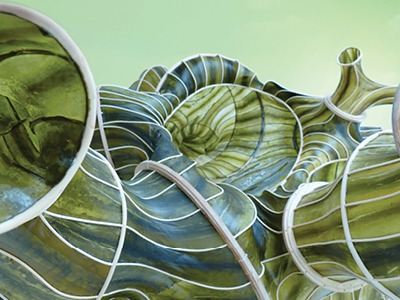
Julia Lohmann, Kombu Ahtola, 2020, Photo: Alberte Holmø Bojesen ©Julia Lohmann, Courtesy: the artist
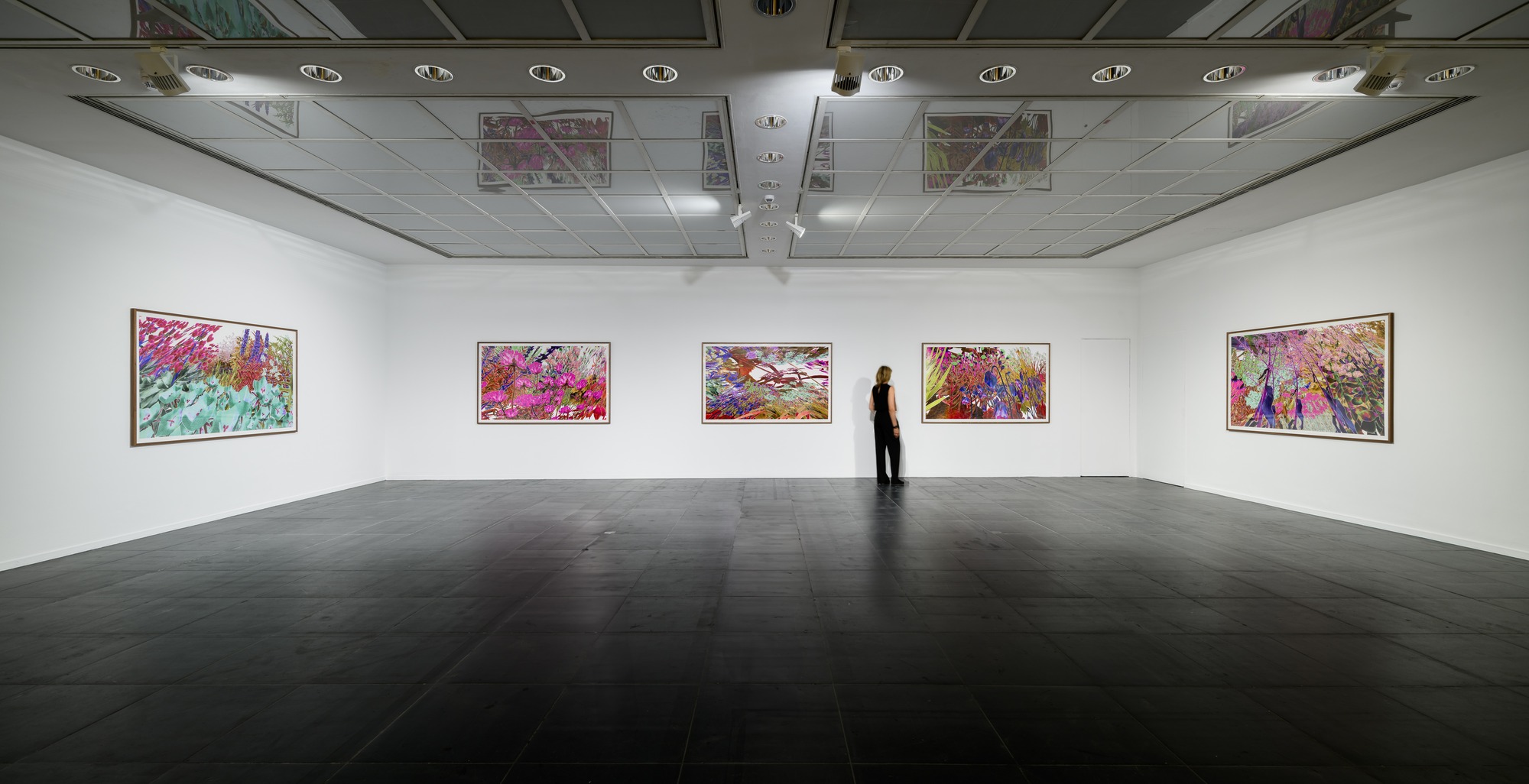
Alexandra Daisy Ginsberg, Pollinator Pathmaker: AfyLbwTriWhuR7PDkd77LZ (Pollinator Vision, Late Spring), Pollinator Pathmaker: ARr77zvQW8Bq8q6hgDHUmp (Pollinator Vision, Late Summer), Pollinator Pathmaker: AfyLbwTriWhuR7PDkd77LZ (Pollinator Vision, Late Summer), Pollinator Pathmaker: iFADDiPqc5HU3KiFxjBEuG (Pollinator Vision, Early Summer), Pollinator Pathmaker: AfyLbwTriWhuR7PDkd77LZ (Pollinator Vision, Midsummer), 2023, installation view Frankfurter Kunstverein 2023, Photo: Moritz Bernoully, ©Frankfurter Kunstverein, Courtesy: Alexandra Daisy Ginsberg Ltd.
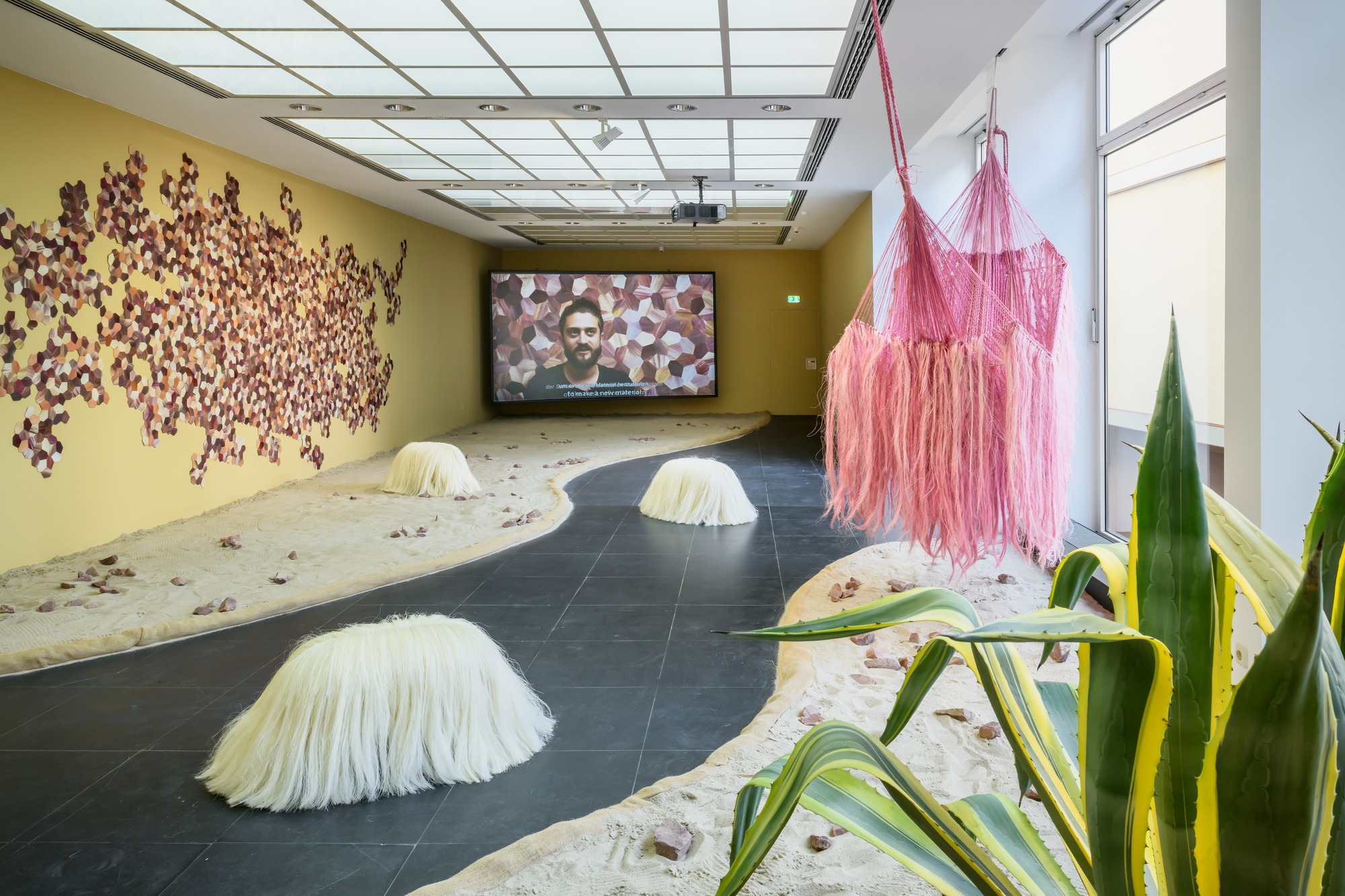
Fernando Laposse, Totomoxtle (2023), dog benches (pups) (2023), Pink Hammock (2019), Film Totomoxtle (2019), 2023, Installation view Frankfurter Kunstverein 2023, Photo: Moritz Bernoully, ©Frankfurter Kunstverein, Courtesy: Fernando Laposse and Friedman Benda
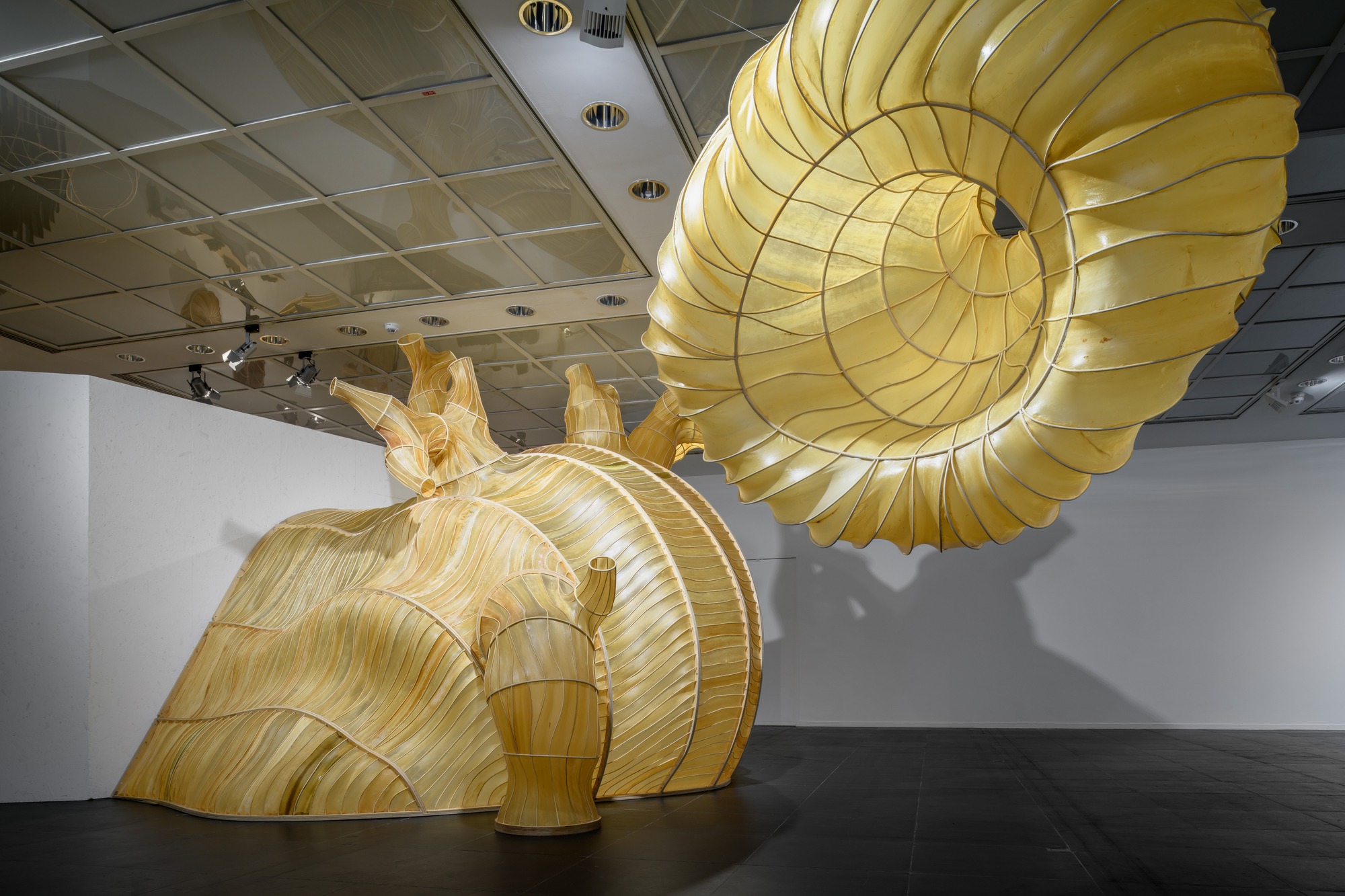
Julia Lohmann, Hidaka Ohmu (2020) and Corpus Maris II (2023), installation view Frankfurter Kunstverein 2023, Photo: Moritz Bernoully, ©Frankfurter Kunstverein, Courtesy: Julia Lohmann Studio
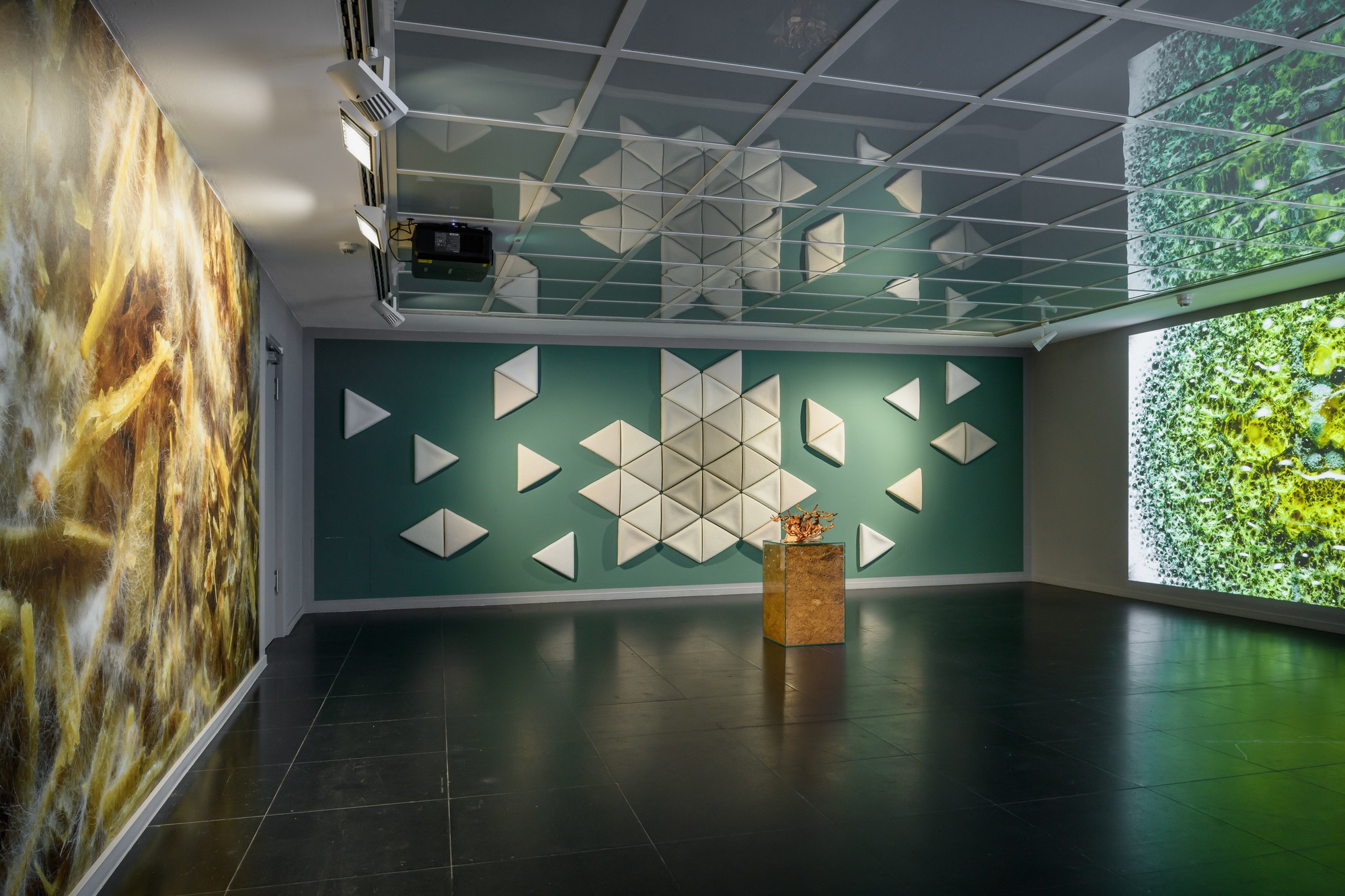
Maurizio Montalti, RECIPROCITY // Metabolic Transformation (2023), RECIPROCITY // Mogu Acoustic ASPEN Tiles (2023), RECIPROCITY // The Alchemist – Ganoderma lucidum (2021), RECIPROCITY // The Lower Fungi, filmed by Wim van Egmond (2023) , installation view Frankfurter Kunstverein 2023, Photo: Moritz Bernoully, ©Frankfurter Kunstverein, Courtesy: Maurizio Montalti / Mogu; Officina Corpuscoli & Wim van Egmond
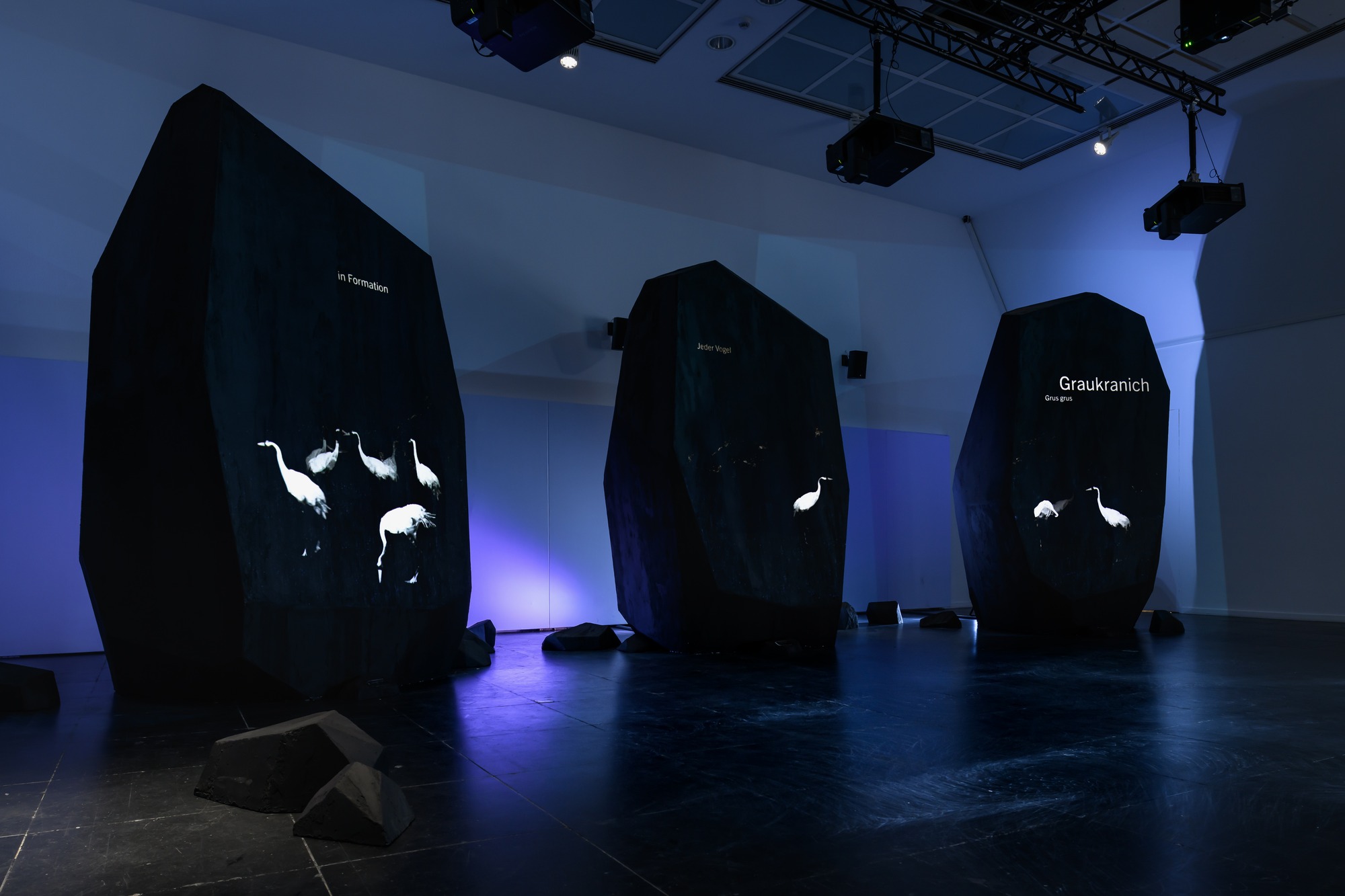
MYRIAD. Where we connect., 2023, installation view Frankfurter Kunstverein 2023, Photo: Moritz Bernoully, ©Frankfurter Kunstverein, Courtesy: Interactive Media Foundation
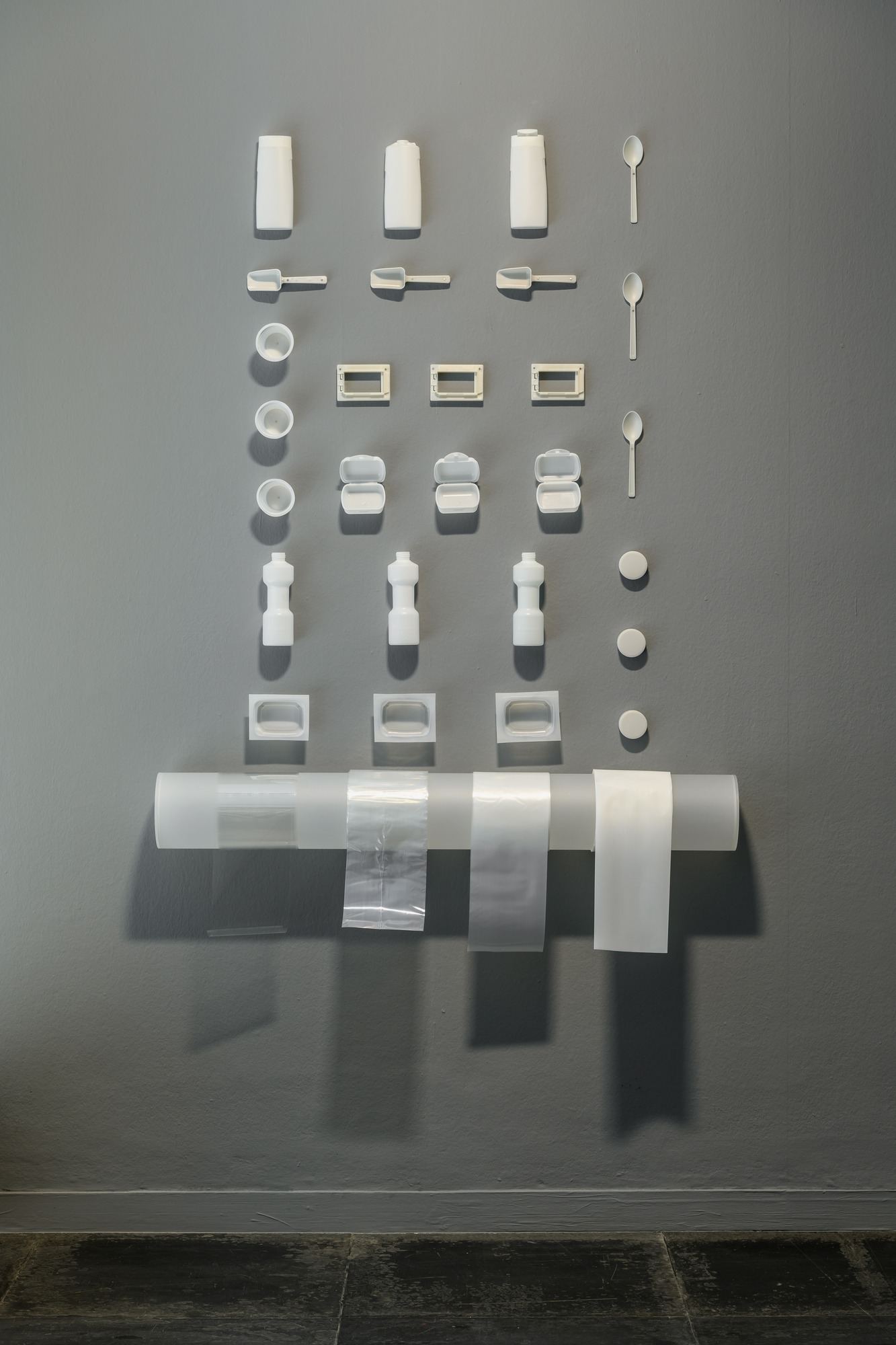
Fraunhofer-Institut für Angewandte Polymerforschung (IAP), Fresh-keeping containers, cream jars, cable pass-throughs, and screw caps (injection molding), yogurt cups and trays (thermoforming), drink and shampoo bottles (blow molding), films (flat and blown films) made from Polybutylene Succinate, installation view Frankfurter Kunstverein 2023, Photo: Moritz Bernoully, ©Frankfurter Kunstverein, Courtesy: Fraunhofer Institute for Applied Polymer Research IAP
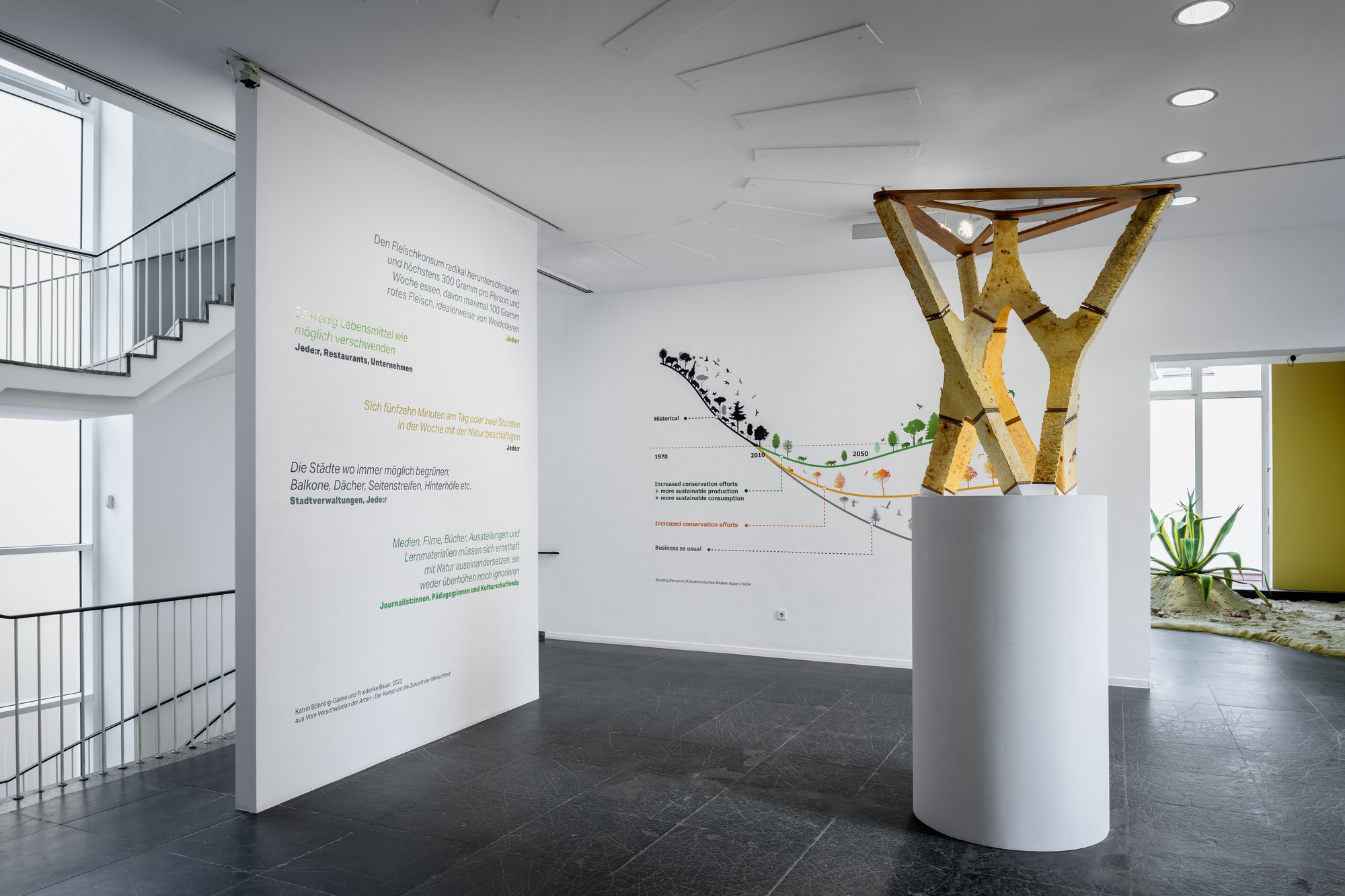
Catalog of ten measures for biodiversity, Bending the Curve of Biodiversity Loss, MycoTree (2017), installation view Frankfurter Kunstverein 2023, Photo: Moritz Bernoully, ©Frankfurter Kunstverein, Courtesy: Katrin Böhning-Gaese, Friederike Bauer; International Institute for Applied System Analysis, IIASA; Karlsruher Institut für Technologie, Fakultät für Architektur
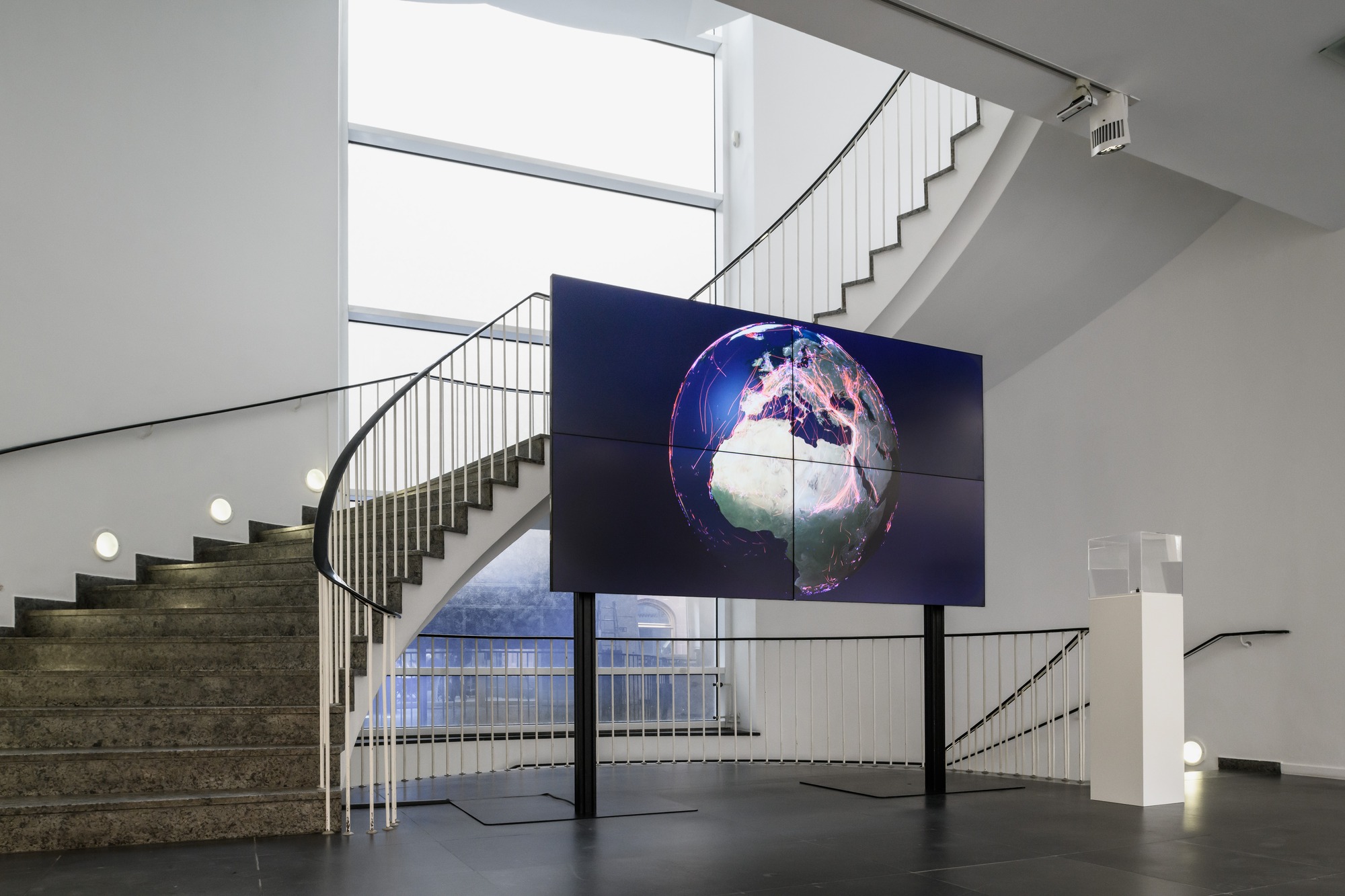
Max-Planck-Institut für Verhaltensbiologie, Abteilung Tierwanderungen, Movebank, ICARUS Basic tag - Wearable for wildlife, installation view Frankfurter Kunstverein 2023, Photo: Moritz Bernoully, ©Frankfurter Kunstverein, Courtesy: Max-Planck-Institut für Verhaltensbiologie, Rohde & Schwarz INRADIOS GmbH, TALOS GmbHa
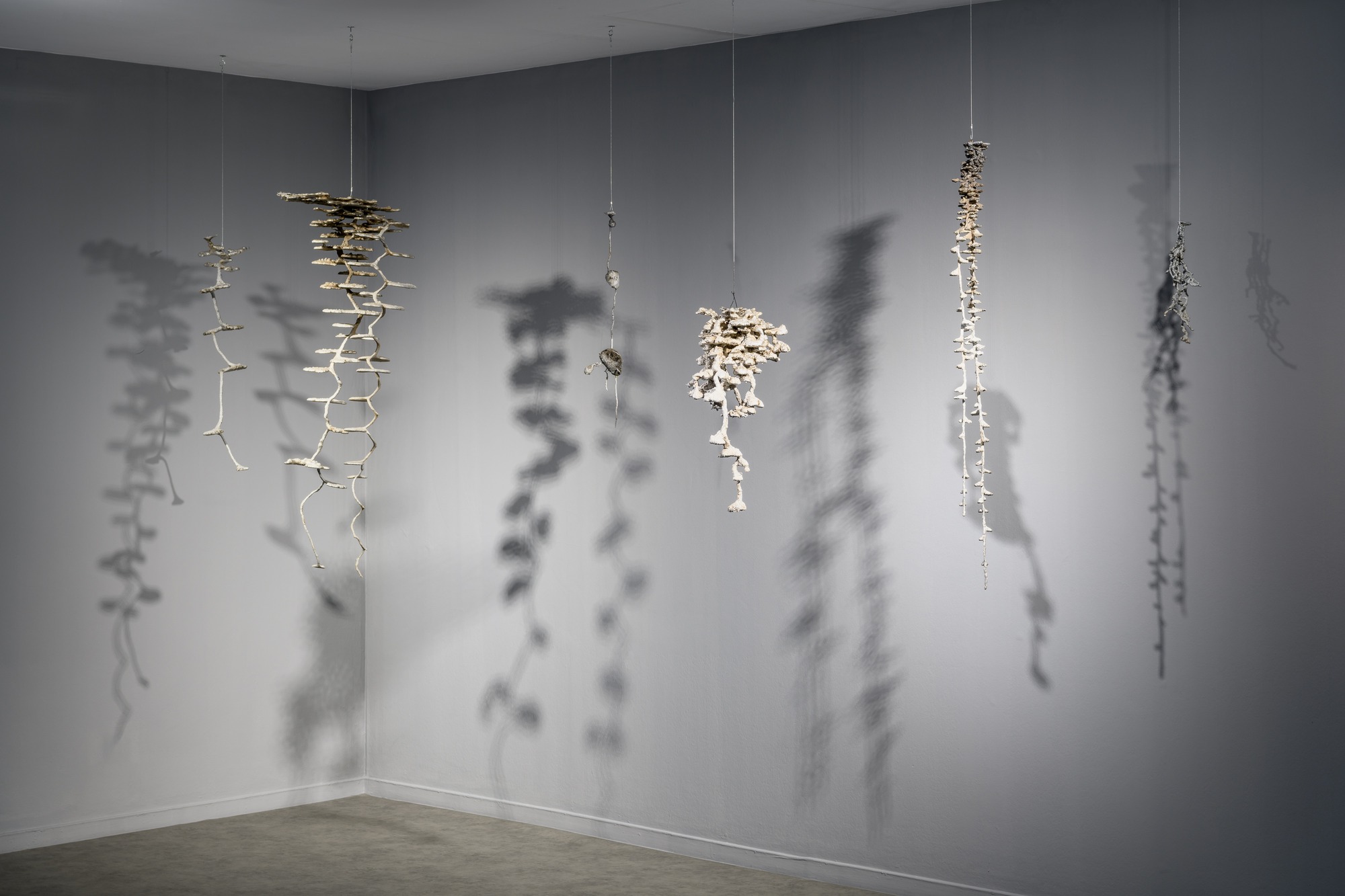
Walter R. Tschinkel, Six tin castings of architectures of ant nests of different species Camponotus socius, Pogonomyrmex badius, Trachymyrmex septentrionalis, Formica Dolosa, Pheidole morrisi, Cyphomyrmex rimosus, installation view Frankfurter Kunstverein, Photo: Moritz Bernoully, ©Frankfurter Kunstverein, Courtesy: Walter R. Tschinkel
Opening: Thursday, October 12, 2023, at 7 pm
Co-Creation Art: Prof. Franziska Nori
Co-Creation Science: Prof. Dr. Katrin Böhning-Gaese
In collaboration with the Senckenberg Biodiversity and Climate Research Centre and Frankfurt Zoo
Alexandra Daisy Ginsberg / Fernando Laposse / Julia Lohmann / Maurizio Montalti /
MYRIAD. Where we connect. / Fraunhofer Institute for Applied Polymer Research IAP /
Karlsruhe Institute of Technology, Faculty of Architecture / Max Planck Institute of Animal Behavior / Walter R. Tschinkel / Frankfurt Zoo
Bending the Curve – Positive Narratives and Concrete Action Models
Without biodiversity, human existence on planet Earth would not be possible. However, this biodiversity has been declining for far too long, and at an alarming rate. This realisation unites the curatorial team of the Frankfurter Kunstverein, which has invited the Senckenberg Biodiversity and Climate Research Centre and Frankfurt Zoo to collaborate in the form of an interdisciplinary partnership. The result is the new exhibition titled Bending the Curve – Knowledge, Action, Caring for Biodiversity, which alludes to the concept of ‘Bending the Curve of Biodiversity Loss’. The exhibition explores how the negative trend can be halted – or even reversed. This issue is also the focus of the artistic and scientific perspectives presented in the exhibition, which illustrate paths and ideas for ecosystemic recovery and aim to catalyse a turnaround in the biodiversity crisis.
Franziska Nori (Co-Creation Art) and Katrin Böhning-Gaese (Co-Creation Science) have invited internationally renowned and innovative artists to present current works, some of which were specifically created for the Frankfurter Kunstverein. These works include expansive installations as well as pieces from the realm of computer-generated reality. At the Frankfurter Kunstverein, these artworks intersect with perspectives that illuminate the exhibition theme from a scientific standpoint. This includes Big Data models, virtual reality experiences, a living ant colony, as well as results from innovative material research and citizen science projects.
Both the artistic and scientific exhibits go beyond symbolic references. Instead, Bending the Curve showcases artists, research projects and initiatives whose work focuses on active transformation. What they present in the exhibition is born from the idea of co-creation, representing a shared interdisciplinary creative process that encompasses creatures both human and non-human.
The exhibits and their creation demonstrate where a shift in thinking and action, as well as a new prioritisation of values, may lead to. Built upon the foundation of knowledge, action and care for biodiversity, as formulated in the sub-title, the creators and their works advocate a departure from anthropocentrism towards the concept of transformative ‘naturecultures’, as coined by Donna Haraway. The forward-looking stance of the artists showcased in Frankfurt also stems from their presentation of not just sustainable but regenerative art. Unlike sustainability, which aims to preserve resources and minimise negative impacts, regenerative art focuses on co-existence with ecosystems. This necessitates aligning the coordinates of daily life in a way that creates a liveable social environment while simultaneously contributing to the recovery, renewal, and perhaps even complete health of the environment.
The exhibition at Frankfurter Kunstverein draws inspiration from the project ‘Bending the Curve of Biodiversity Loss’. Behind it is concealed an international network led by Dr. David Leclère, with 60 scientists and 46 institutions as members. Demonstrating that socio-ecological transformation is still possible despite challenging conditions, they call upon civil society, as well as politics and business, to act accordingly.
The Frankfurter Kunstverein sees itself as a cultural forum situated in the midst of society. Through the media of art and visual thinking, artists and experts from various fields engage in a public discourse with civil society actors, inspiring in this way political action.
Following the exhibitions Trees of Life – Stories for a Damaged Planet, 2019, and The Intelligence of Plants, 2021, the Frankfurter Kunstverein with Bending the Curve continues its series of collaborations between contemporary artists and international natural science research institutions.
Art and Science: An Interdisciplinary Collaboration
For Bending the Curve, the Frankfurter Kunstverein has invited two strong partner institutions from Frankfurt: the Senckenberg Biodiversity and Climate Research Centre and Frankfurt Zoo. The exhibition was developed and created by Prof. Franziska Nori (Co-Creation Art) and Prof. Dr. Katrin Böhning-Gaese (Co-Creation Science) in the form of close collaboration. Both were supported by Dr. Christina Geiger (Frankfurt Zoo).
Prof. Franziska Nori has been leading the Frankfurter Kunstverein since 2014. Under her leadership, a programme has been developed that explores societal issues at the intersection of art and science. For this, she and the Frankfurter Kunstverein have received numerous awards for best exhibition: Binding Cultural Award 2019, Exhibition Prize 2020 from the Dr. Marschner Foundation, and the art Curator’s Prize 2022 from art – Das Kunstmagazin.
Prof. Dr. Katrin Böhning-Gaese, an expert in biodiversity, distinguishes herself not only through her work as a scientist and as director of the Senckenberg Biodiversity and Climate Research Centre, she is also the recipient of the German Environmental Award 2021. Her involvement on political advisory committees and as part of international forums further establishes her as an expert in the struggle for biodiversity conservation.
Frankfurt Zoo, led by Dr. Christina Geiger, is a pioneer in the field of species protection and biodiversity. Through its dedicated research and educational endeavours, the zoo actively contributes to the preservation of endangered species and habitats.
Among the scientific research institutions invited to present their findings in Frankfurt are the Fraunhofer Institute for Applied Polymer Research IAP (Dr. Thomas Büsse and Dr. Jens Balko), the Max Planck Institute of Animal Behavior (Prof. Dr. Martin Wikelski and his team), the Karlsruhe Institute of Technology (Prof. Dr. Dirk Hebel and the Faculty of Architecture). Numerous exhibits in the show were developed jointly with these scientists.
The transition from knowledge to action is represented by a selection of young companies: Magna Glaskeramik, Blue Blocks Seawood, Compost Board, Plasticiet, Shards Tiles from construction waste, Smile Plastics, Spared, Stone Cycling, UpBoards and Mogu. They all exemplify innovative practices in the field of New Materials. The focus here is on recycling, urban mining and the use of naturally renewable and bio-degradable resources.
The curatorial team distinguishes itself by turning expert knowledge into an experience both sensory and visual. This includes an extensive accompanying programme. The motivation for the exhibition itself, and indeed for the collaboration between the Frankfurter Kunstverein and scientific institutions, is that of mutual knowledge transfer between science and society.
Co-Creation Art: Prof. Franziska Nori
Co-Creation Science: Prof. Dr. Katrin Böhning-Gaese
In collaboration with the Senckenberg Biodiversity and Climate Research Centre and Frankfurt Zoo
Alexandra Daisy Ginsberg / Fernando Laposse / Julia Lohmann / Maurizio Montalti /
MYRIAD. Where we connect. / Fraunhofer Institute for Applied Polymer Research IAP /
Karlsruhe Institute of Technology, Faculty of Architecture / Max Planck Institute of Animal Behavior / Walter R. Tschinkel / Frankfurt Zoo
Bending the Curve – Positive Narratives and Concrete Action Models
Without biodiversity, human existence on planet Earth would not be possible. However, this biodiversity has been declining for far too long, and at an alarming rate. This realisation unites the curatorial team of the Frankfurter Kunstverein, which has invited the Senckenberg Biodiversity and Climate Research Centre and Frankfurt Zoo to collaborate in the form of an interdisciplinary partnership. The result is the new exhibition titled Bending the Curve – Knowledge, Action, Caring for Biodiversity, which alludes to the concept of ‘Bending the Curve of Biodiversity Loss’. The exhibition explores how the negative trend can be halted – or even reversed. This issue is also the focus of the artistic and scientific perspectives presented in the exhibition, which illustrate paths and ideas for ecosystemic recovery and aim to catalyse a turnaround in the biodiversity crisis.
Franziska Nori (Co-Creation Art) and Katrin Böhning-Gaese (Co-Creation Science) have invited internationally renowned and innovative artists to present current works, some of which were specifically created for the Frankfurter Kunstverein. These works include expansive installations as well as pieces from the realm of computer-generated reality. At the Frankfurter Kunstverein, these artworks intersect with perspectives that illuminate the exhibition theme from a scientific standpoint. This includes Big Data models, virtual reality experiences, a living ant colony, as well as results from innovative material research and citizen science projects.
Both the artistic and scientific exhibits go beyond symbolic references. Instead, Bending the Curve showcases artists, research projects and initiatives whose work focuses on active transformation. What they present in the exhibition is born from the idea of co-creation, representing a shared interdisciplinary creative process that encompasses creatures both human and non-human.
The exhibits and their creation demonstrate where a shift in thinking and action, as well as a new prioritisation of values, may lead to. Built upon the foundation of knowledge, action and care for biodiversity, as formulated in the sub-title, the creators and their works advocate a departure from anthropocentrism towards the concept of transformative ‘naturecultures’, as coined by Donna Haraway. The forward-looking stance of the artists showcased in Frankfurt also stems from their presentation of not just sustainable but regenerative art. Unlike sustainability, which aims to preserve resources and minimise negative impacts, regenerative art focuses on co-existence with ecosystems. This necessitates aligning the coordinates of daily life in a way that creates a liveable social environment while simultaneously contributing to the recovery, renewal, and perhaps even complete health of the environment.
The exhibition at Frankfurter Kunstverein draws inspiration from the project ‘Bending the Curve of Biodiversity Loss’. Behind it is concealed an international network led by Dr. David Leclère, with 60 scientists and 46 institutions as members. Demonstrating that socio-ecological transformation is still possible despite challenging conditions, they call upon civil society, as well as politics and business, to act accordingly.
The Frankfurter Kunstverein sees itself as a cultural forum situated in the midst of society. Through the media of art and visual thinking, artists and experts from various fields engage in a public discourse with civil society actors, inspiring in this way political action.
Following the exhibitions Trees of Life – Stories for a Damaged Planet, 2019, and The Intelligence of Plants, 2021, the Frankfurter Kunstverein with Bending the Curve continues its series of collaborations between contemporary artists and international natural science research institutions.
Art and Science: An Interdisciplinary Collaboration
For Bending the Curve, the Frankfurter Kunstverein has invited two strong partner institutions from Frankfurt: the Senckenberg Biodiversity and Climate Research Centre and Frankfurt Zoo. The exhibition was developed and created by Prof. Franziska Nori (Co-Creation Art) and Prof. Dr. Katrin Böhning-Gaese (Co-Creation Science) in the form of close collaboration. Both were supported by Dr. Christina Geiger (Frankfurt Zoo).
Prof. Franziska Nori has been leading the Frankfurter Kunstverein since 2014. Under her leadership, a programme has been developed that explores societal issues at the intersection of art and science. For this, she and the Frankfurter Kunstverein have received numerous awards for best exhibition: Binding Cultural Award 2019, Exhibition Prize 2020 from the Dr. Marschner Foundation, and the art Curator’s Prize 2022 from art – Das Kunstmagazin.
Prof. Dr. Katrin Böhning-Gaese, an expert in biodiversity, distinguishes herself not only through her work as a scientist and as director of the Senckenberg Biodiversity and Climate Research Centre, she is also the recipient of the German Environmental Award 2021. Her involvement on political advisory committees and as part of international forums further establishes her as an expert in the struggle for biodiversity conservation.
Frankfurt Zoo, led by Dr. Christina Geiger, is a pioneer in the field of species protection and biodiversity. Through its dedicated research and educational endeavours, the zoo actively contributes to the preservation of endangered species and habitats.
Among the scientific research institutions invited to present their findings in Frankfurt are the Fraunhofer Institute for Applied Polymer Research IAP (Dr. Thomas Büsse and Dr. Jens Balko), the Max Planck Institute of Animal Behavior (Prof. Dr. Martin Wikelski and his team), the Karlsruhe Institute of Technology (Prof. Dr. Dirk Hebel and the Faculty of Architecture). Numerous exhibits in the show were developed jointly with these scientists.
The transition from knowledge to action is represented by a selection of young companies: Magna Glaskeramik, Blue Blocks Seawood, Compost Board, Plasticiet, Shards Tiles from construction waste, Smile Plastics, Spared, Stone Cycling, UpBoards and Mogu. They all exemplify innovative practices in the field of New Materials. The focus here is on recycling, urban mining and the use of naturally renewable and bio-degradable resources.
The curatorial team distinguishes itself by turning expert knowledge into an experience both sensory and visual. This includes an extensive accompanying programme. The motivation for the exhibition itself, and indeed for the collaboration between the Frankfurter Kunstverein and scientific institutions, is that of mutual knowledge transfer between science and society.
